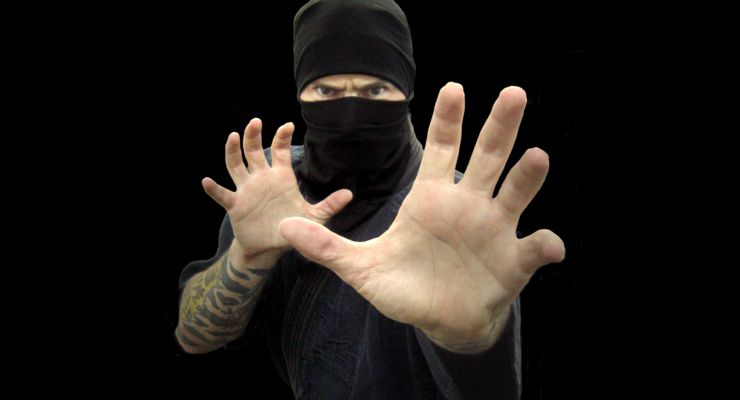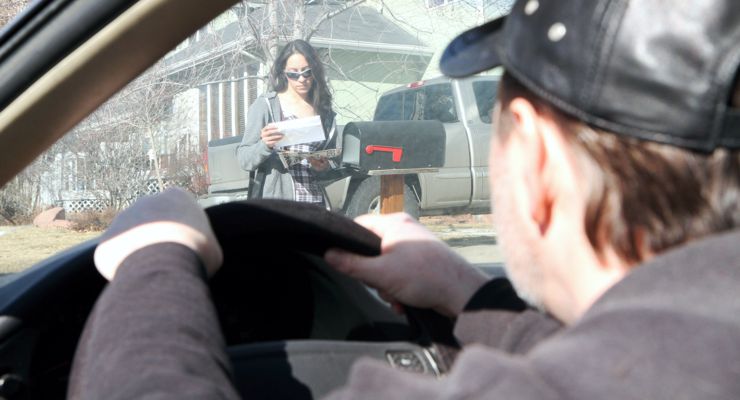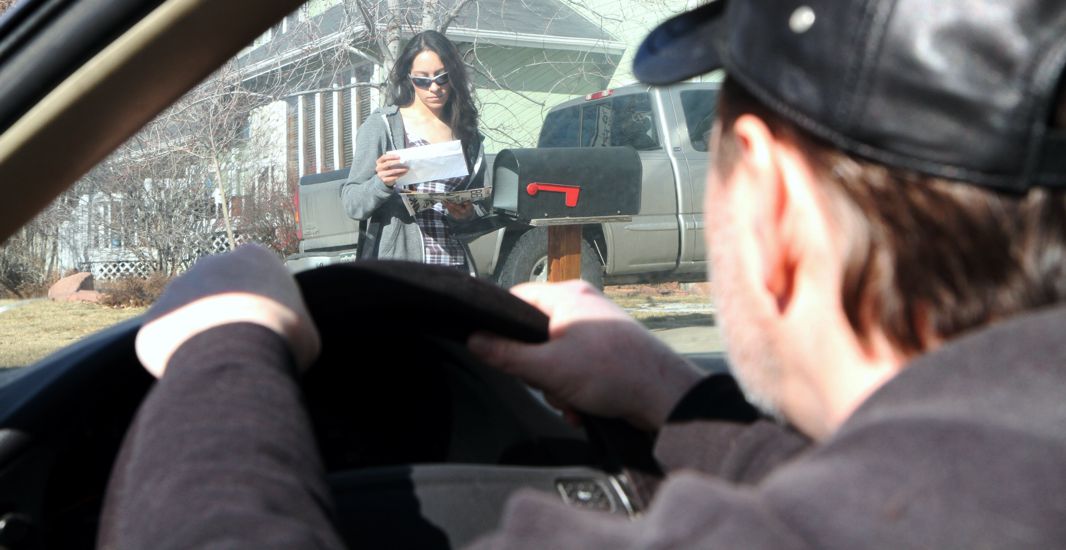If having the skills of a Ninja does not absolutely ensure victory, how can an average person with fundamental self-defense skills hope to survive a violent encounter?
Kurai Kotori Ninjutsu is an amazing style with a vast array of arts and sub-arts that make it one of the most versatile fighting systems ever created. Do I say this because Ninja fighting skills are superior to those of other systems? No. Effective fighting skills can be learned in many martial arts. In my opinion, what makes a Ninja unique is their way of thinking. A Ninja will do whatever must be done to accomplish their mission.
HOW A NINJA APPROACHES CONFLICT
A Ninja does not approach conflict with any preconceived notion of right and wrong or fair and unfair…only what is it going to take to succeed. Thus, a Ninja would never knowingly face an opponent who had superior fighting skills. To do so is to invite the potential of defeat. A more likely tactic for a Ninja would be to manipulate the situation so that they could attack their opponent unaware, greatly increasing their chances of success through surprise.

UNAVOIDABLE CONFRONTATION
However, if a Ninja were forced into a physical confrontation, they would make a quick assessment of the opponent to reveal potential weaknesses at the same time as taking a mental picture of their environment to identify any strategic positions or improvised weapons that would increase their advantage. This conditioned ability to think on their feet to create a sound tactical response to danger is indeed impressive. But, does this ability ensure victory? The obvious answer is no, because fighting is chaotic, nothing remains a constant.
So, if having the skills of a Ninja does not absolutely ensure victory, how can an average person with fundamental self-defense skills hope to survive a violent encounter? The secret lies in taking a page from the book of Ninja strategy and learning to win before the enemy can actually attack you.
THE DEEPER QUESTION
When approaching the concept of self-defense the first question should not be “How do I physically defeat the opponent”, but rather, “What are the events that lead up to the moment where violence erupts”. A Ninja understands that violent crime is a process. It has both a goal and identifiable stages. In order to effectively confront danger, you must understand where it originates. It’s an age old concept. KNOW THY ENEMY.
STAGES OF VIOLENCE
Violent crime does not begin with an attack, it is a 5 stage process. Stages 1-3 are made up of Intention, Probe and Positioning. The 4th stage is the actual Attack and the 5th stage is your Defense. Stages 1-3 are where the aggressor will decide whether or not they can get away with the act, so if you can stop the process within these stages, you can likely prevent the attack without any need for physical response. If not, you will likely be forced into the confrontation.
STAGE 1 – INTENTION
This is where the aggressor crosses a normal mental boundary. Violence doesn’t just “Happen out of nowhere.” Even a habitually violent person will have to mentally prepare themselves. It may happen quickly, but it is not instantaneous. If you do not recognize the buildup, it will appear that the violence suddenly “Erupted”, but that is not the case. It did come from somewhere. You must learn to be aware of someone’s intention based on non-verbal cues. A person who is prepared to engage in physical violence will give off certain warning signals. In essence, their body language will betray their true intentions. This is a collection of “Vibes” that we can usually sense. They range from the physiological (skin flush/pale, muscle tension, unnatural breathing pattern) to physical motion (adrenaline rush, nervousness) to speech patterns (irregular tone, pitch). Some aggressors may be adept at concealing their intention, but if you look close, there is usually something under the surface that promotes an uneasy “Feeling”. Trust that feeling.
STAGE 2 – PROBE
This is where the aggressor will decide whether or not you are vulnerable to attack. People are often amazed to learn that an aggressor is VERY concerned with their own safety and it is a critical factor in deciding whether or not they will attack you. The only time this is not true is when the aggressor is mentally unbalanced and feels compelled to be violent, even when there is no possible chance of success. However, the question “Can I get away with it” is a major factor in what the majority of criminals decide to do. They make their decision based on “Probing” their intended victim. There are many methods in which an aggressor will initiate a probe.

DISTRACTION PROBE
This is the most common method used. The aggressor will approach you under the guise of normalcy, pretending that they need information or a small item like a match to light their cigarette. This is a distraction. While they are talking, they are checking your awareness level and preparing an attack. This is why you must be careful when someone approaches you and asks for something.

HOT PROBE
Hot probes are sudden and emotional attacks against you. One minute you are minding your own business, and the next you have a threatening, obscenity spouting psycho coming down on you. The aggressor’s success relies on you not being accustomed to dealing with extreme emotional violence and reacting in a stunned and confused manner. If you back away in fear, it reveals that you are a prime victim. To counter this tactic, you must be able to immediately shift gears and meet their aggression head on. If you display your commitment to becoming physical, the aggressor may abort.

ESCALATING PROBE
Unlike a hot probe, which starts immediately hostile, an escalating probe starts out in normal conversation and then rapidly turns hostile. The aggressor is testing your boundaries by escalating outrageous behavior. Every time these escalations go un-countered, they will become more and more extreme until the aggressor attacks. This is a very common method in Date Rape situations. It is also common when you walk into a loitering group of young street thugs. What starts out as them “Just messing with you” quickly escalates into robbery or assault…sometimes both.

SILENT PROBE
A silent probe is when the aggressor puts themselves into a position to observe you. They may never speak to you at all…but they have been watching you all along. They usually position themselves out of sight and follow you at a discreet distance. If you become aware of their presence, it is important that you do not show fear or anxiety because it might make them feel more confident in their attack. You should move as quickly as possible to a safe location without giving it away that you sense them at all.

PROLONGED PROBE
The Prolonged probe usually takes the form of someone stalking you, or watching your home to study your comings and goings. This probe can also take the form of a person who is very nice, working to gain your trust over a period of time, waiting for an opportunity to victimize you. With a prolonged probe, the intent is seldom obvious…which is what makes it so dangerous.

STAGE 3 – POSITIONING
This is the aggressor putting themselves in a position where they can successfully attack you, or you venturing into a less than safe environment on your own. In most cases an aggressor does not want to fight you, they want to overwhelm you. To do this, they must get you in an environment where they are in control and they can attack you quickly and effectively. It is not as likely that you will be robbed or raped in the middle of a crowd. However, aggressors usually attack people in areas where you are not far from people, but out of range of immediate help. You won’t be mugged in the mall, but you may be mugged in a mall bathroom or mall parking lot. ATM’s, parking lots, stairwells, public bathrooms and sidewalks should all be considered potential danger areas. Even a separate room in a crowded house can be isolated enough to be used by an aggressor.

CLOSING POSITION
The most basic form of positioning is simply walking up to the victim. The closer an aggressor gets, the greater their ability to overwhelm and control. Five feet is the closest you should allow someone you don’t know to get to you. If the person comes closer than 5 feet after you have asked them not to, they have clearly announced their intention.

CORNERING / TRAPPING POSITION
This is another common method of positioning. The aggressor approaches to from a direction that traps you between them and a large object, like a car or a wall. This also entails them placing themselves between you and an exit.

SURPRISE POSITION
This is your classic jump-out-of-the-bushes type of position. The aggressor puts themselves in a place where you do not see them (or if you do, it is at the last minute). From this position, they can easily step out and attack. In order to combat this position, you must think like an attacker yourself. If you were going to lay in wait to attack someone, how would you do it? Once you start playing these scenarios in your head, you will begin to recognize potential places an enemy could use to get the drop on you…and you can avoid them.

DUO POSITION
Professional criminals often work in pairs. The most common maneuver for these aggressors is to have one circle around while the other distracts you. You should always be aware of individuals who split apart when they see you approaching. These partners in crime will also act as lookouts for one another, allowing one of them to perform a rape or robbery while the other ensures that if someone notices the act, they can get away quickly.

PACK POSITION
Strength comes in numbers. This is important to remember. Like the Duo method, one person will distract while the others surround. They can swarm around you, but most often they will casually drift. A serious danger sign is when a group is spaced out along a wall on a walkway…when you walk by, both ends simply close up around you.

STAGE 4 – ATTACK
The attack is the aggressor resorting to violence to get what they want. If the first three stages have been achieved, the possibility of an attack is fairly high. The aggressor will use threats of violence, display weapons to cause fear, or actually physically assault you at this stage.

STAGE 5 – DEFENSE
The final stage is based on your ability to ward off someone who has committed to attacking you. This is where your physical and mental preparation to fight comes into play. But keep in mind that self-defense instructors will often tell you to poke the eyes, kick the groin, or strike the throat. Although these are all effective attacks, do you think the bad guys (who are willing to put themselves in danger to accost you) are not prepared for physical resistance? The attacker will likely have fighting instincts, adrenaline enhanced pain tolerances, and are most likely desperate with little to lose. So although self-defense skills will increase our chances of survival, does having these abilities ensure victory? The obvious answer is no, because, fighting is chaotic, nothing remains a constant.
This means there is no universal “easy” fighting techniques that will stop an attacker. Short term self-defense programs may enlighten you to how to pick vital targets and how to strike properly, but in the end, you are facing an opponent(s) who is most likely a product of an unfortunate environment that has been conditioned into a life of violence. They are not attacking you unprepared. The only solution is that you understand the potential danger and are ready and willing to face it at every stage.

In conclusion – Self-Defense begins long before an attack is initiated. If you understand the process of violence, there are many possibilities to diffuse the situation before the need for hand to hand combat is required.
Danger can be averted at Stage 1 (intention) if you trust your feeling and escape the situation.
Danger can be averted at Stage 2 (probe) if you are prepared to respond properly to the opponent’s tactics.
Danger can be averted at Stage 3 (positioning) if you can avoid allowing the opponent to put you in a place that limits your ability to avoid the situation.
Danger can be averted at Stage 4 (attack) if there is the possibility of escape. Fleeing is a valid method of defense. If the option of running away exists, take it. If escape is not possible…you must fight.
Danger at Stage 5 (defense) can be effectively dealt with if you have the proper knowledge and training to do so.






